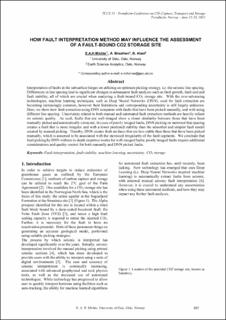| dc.contributor.author | Michie, E.A.H. | |
| dc.contributor.author | Braathen, A. | |
| dc.contributor.author | Alaei, B. | |
| dc.date.accessioned | 2021-09-30T07:18:38Z | |
| dc.date.available | 2021-09-30T07:18:38Z | |
| dc.date.issued | 2021 | |
| dc.identifier.isbn | 978-82-536-1714-5 | |
| dc.identifier.issn | 2387-4295 | |
| dc.identifier.uri | https://hdl.handle.net/11250/2786445 | |
| dc.description.abstract | Interpretation of faults in the subsurface hinges on utilizing an optimum picking strategy, i.e. the seismic line spacing. Differences in line spacing lead to significant changes in subsequent fault analyses such as fault growth, fault seal and fault stability, all of which are crucial when analyzing a fault-bound CO2 storage site. With the ever-advancing technologies, machine learning techniques, such as Deep Neural Networks (DNN), used for fault extraction are becoming increasingly common, however their limitations and corresponding uncertainty is still largely unknown. Here, we show how fault extraction using DNN compares with faults that have been picked manually, and with using different line spacing. Uncertainty related to both manual and automated fault extraction methods are heavily reliant on seismic quality. As such, faults that are well-imaged show a closer similarity between those that have been manually picked and automatically extracted. In cases of poorly imaged faults, DNN picking on narrower line spacing creates a fault that is more irregular and with a lower predicted stability than the smoother and simpler fault model created by manual picking. Thereby, DNN creates fault surfaces that are less stable than those that have been picked manually, which is assumed to be associated with the increased irregularity of the fault segments. We conclude that fault picking by DNN without in-depth expertise works for well-imaged faults; poorly imaged faults require additional considerations and quality control for both manually and DNN picked faults. | en_US |
| dc.language.iso | eng | en_US |
| dc.publisher | SINTEF Academic Press | en_US |
| dc.relation.ispartof | TCCS–11. CO2 Capture, Transport and Storage. Trondheim 22nd–23rd June 2021.
Short Papers from the 11th International Trondheim CCS Conference | |
| dc.relation.ispartofseries | SINTEF Proceedings;7 | |
| dc.rights | CC BY 4.0 | * |
| dc.rights.uri | https://creativecommons.org/licenses/by/4.0/ | * |
| dc.subject | Fault interpretation | en_US |
| dc.subject | Fault stability | en_US |
| dc.subject | Machine learning | en_US |
| dc.subject | Uncertainty | en_US |
| dc.subject | CO2 storage | en_US |
| dc.title | How Fault Interpretation Method may Influence the Assessment of a Fault-Bound C02 Storage Site | en_US |
| dc.type | Chapter | en_US |
| dc.type | Peer reviewed | en_US |
| dc.type | Conference object | en_US |
| dc.description.version | publishedVersion | en_US |
| dc.rights.holder | © 2021 The Authors. Published by SINTEF Academic Press. | en_US |
| dc.subject.nsi | VDP::Teknologi: 500 | en_US |
| dc.relation.project | Norges forskningsråd: 295061 | en_US |
| dc.relation.project | Norges forskningsråd: 257579 | en_US |

